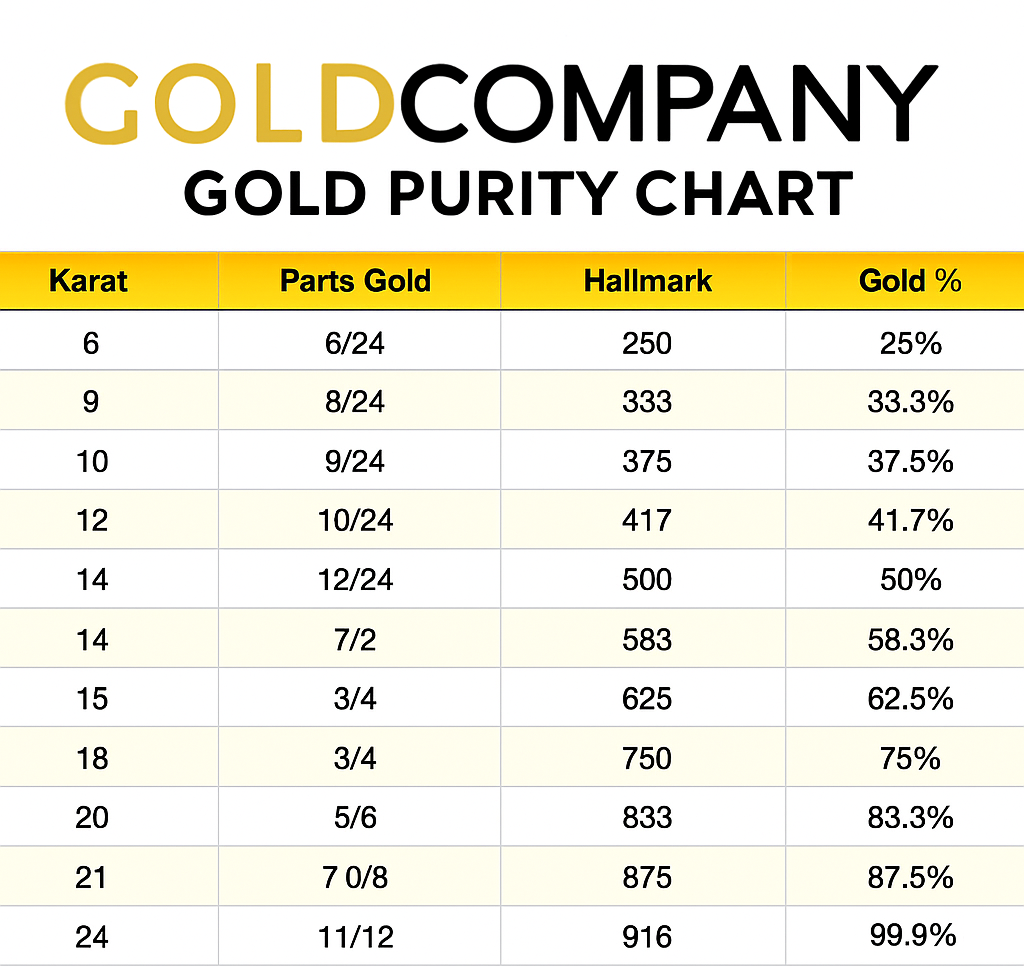Gold has captivated humanity for centuries, symbolising wealth, beauty, and timeless value. But not all gold is created equal. From the shimmering yellow of 24-karat gold to the soft blush of rose gold or the silvery gleam of white gold, the purity and alloy composition determine its colour, strength, and value. Understanding these differences is essential for anyone buying, selling, or investing in gold jewellery.
What Does Gold Purity Mean?
Gold purity is measured in karats (K), with 24K gold being the purest form 99.9% gold. Because pure gold is soft and easily scratched, it is often alloyed with other metals to enhance its durability and alter its colour.
- 24K Gold (99.9%) – Bright yellow, soft, and mainly used for investment or high-end pieces.
- 22K Gold (91.6%) – Common in fine jewellery; retains a rich yellow colour but is slightly stronger.
- 18K Gold (75%) – Popular balance of purity and strength; used in luxury jewellery.
- 14K and 9K Gold (58.3% and 37.5%) – Harder, more affordable, and better suited for everyday wear.
The hallmark stamped on gold items (like 750 for 18K or 585 for 14K) indicates the metal’s purity level, providing buyers with a reliable guide to authenticity.
Why Gold Is Mixed with Other Metals
Pure gold (24K) is too soft for practical use in most jewellery. To strengthen it and adjust its hue, jewellers mix it with various metals, creating different types of alloys. The choice of alloy not only affects durability but also changes the gold’s appearance and sometimes even its hypoallergenic properties.
Let’s explore the most common metals used in gold alloys:
1. Gold and Silver: Soft and Subtle
When gold is mixed with silver, the result is a lighter yellow or slightly greenish tone. This combination produces a softer metal, often used in antique or vintage-style pieces.
- Pros: Beautiful warm hue, easy to work with, affordable.
- Cons: Tarnishes over time and is less durable than other alloys.
2. Gold and Platinum: Rare and Durable
Platinum is a noble metal, extremely resistant to corrosion and wear. Mixing gold with platinum produces a dense, strong alloy that maintains its lustre for generations.
- Pros: Exceptional strength, hypoallergenic, luxurious.
- Cons: Expensive, heavy, and more difficult to craft due to platinum’s hardness.
3. Gold and Palladium: The Modern White Gold
Palladium, part of the platinum family, is often used to create white gold. It gives gold a silvery-white tone without the need for rhodium plating, unlike nickel-based white gold.
- Pros: Naturally white, lightweight, hypoallergenic, resistant to tarnish.
- Cons: More costly than nickel alloys, slightly less bright than rhodium-plated finishes.
4. Gold and Base Metals (Nickel, Copper, Zinc): Affordable and Versatile
Base metals like nickel, copper, and zinc are commonly added to gold to increase hardness and produce various shades, from rose to white and green gold.
- Nickel: Creates white gold but can cause allergic reactions in sensitive skin.
- Copper: Produces rose or red gold, giving jewellery a romantic pink tone.
- Zinc: Used to strengthen gold and prevent oxidation, often included in yellow gold alloys.
Pros: Strong, affordable, versatile in colour creation.
Cons: May cause allergies (nickel), and colours can fade over time.
Choosing the Right Gold for You
- For luxury and investment: Choose 22K–24K gold for its purity and long-term value.
- For everyday wear: 14K–18K gold offers the best balance of strength and beauty.
- For sensitive skin: Opt for palladium or platinum alloys instead of nickel-based gold.
- For colour variety: Rose and white gold allow for creative design options without sacrificing durability.
Final Thoughts
Gold’s beauty lies in its versatility. Whether alloyed with silver for subtle elegance or with platinum for durability, each combination offers unique characteristics that suit different tastes, styles, and budgets.
At GoldCompany, we understand the importance of purity, craftsmanship, and value. Our experts can help you identify the exact gold type and purity of your jewellery ensuring you receive the highest return or the perfect piece for your collection.


Comments are closed